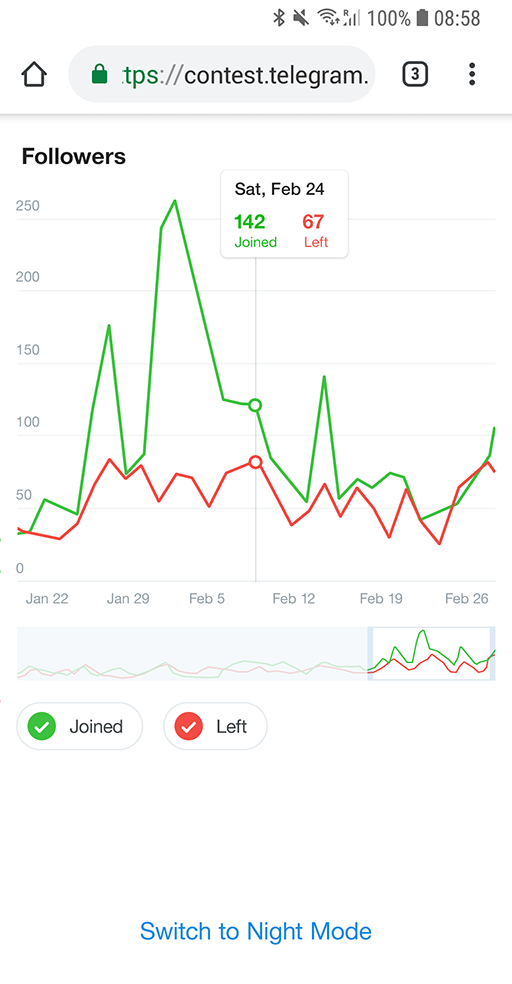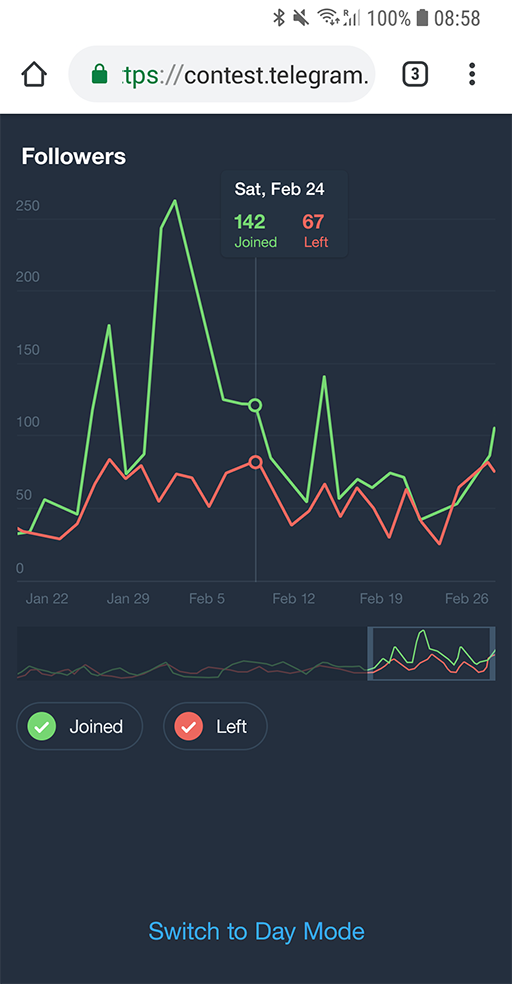chartogram
Charts in JS with no dependencies.
DEMO
Originally created as part of Telegram Charts Contest.
Screenshots
Day
View in full resolution

Night
View in full resolution

Use
The default exported function takes four arguments:
- The DOM element where the chart will be rendered.
- Chart data.
- Chart title.
- (optional)
options.
Chart data must have shape:
{
x: {
points: Number[]
},
y: {
id: string,
name: string,
points: Number[]
}[]
}
So there must be a single x and one or more ys.
Example:
{
x: {
points: [
1553769000,
1553770000,
1553771000
]
},
y: [
{
id: 'y1',
name: 'Temperature',
points: [
60,
69,
65
]
},
{
id: 'y2',
name: 'CPU load',
points: [
95,
98,
90
]
}
]
}
The default exported function returns another function which must be called in case of "destroying" the chart (it cleans up global event listeners and resets the DOM node).
Browser
<!DOCTYPE html>
<html>
<head>
<script src="https://unpkg.com/chartogram@[version]/bundle/chartogram.js"></script>
<link rel="stylesheet" href="https://unpkg.com/chartogram@[version]/style.css"/>
</head>
<body>
<section id="chart"></section>
<script>
chartogram(document.getElementById('chart'), data, 'Title')
</script>
</body>
</html>
where [version] is an npm package version range (for example, 0.1.x or ^0.1.0).
React
npm install chartogram --save
import React from 'react'
import PropTypes from 'prop-types'
import chartogram from 'chartogram'
import 'chartogram/style.css'
class Chartogram extends React.Component {
static propTypes = {
data: PropTypes.shape({
x: PropTypes.shape({
points: PropTypes.arrayOf(PropTypes.number).isRequired
}).isRequired,
y: PropTypes.arrayOf(PropTypes.shape({
id: PropTypes.string.isRequired,
name: PropTypes.string.isRequired,
points: PropTypes.arrayOf(PropTypes.number).isRequired
})).isRequired
}).isRequired,
title: PropTypes.string.isRequired
}
node = React.createRef()
componentDidMount() {
const { data, title } = this.props
this.cleanUp = chartogram(this.node.current, data, title)
}
componentWillUnmount() {
this.cleanUp
}
render() {
return <section ref={this.node}/>
}
}
Night mode
Add chartogram--night-mode CSS class to the chart <section/> to switch to Night Mode.
Options
formatX(value: number, { long: boolean }) — Formats X axis labels. long option is for the tooltip. Uses Intl.DateTimeFormat by default.formatY(value: number) — Formats Y axis labels (including tooltip). Is Math.round() by default.locale: string — Is used to format dates (the default system locale is used if none supplied).transitionDuration: number — The maximum transition duration (in milliseconds).transitionEasing: string — Is easeOutQuad by default.yAxisTickMarksCount: number — Y axis tick marks count.yAxisPrecision: number — Y axis tick mark labels rounding precision (if using fractional Y points). Is 0 by default.xAxisTickMarkWidth: number — (in pixels) Is used to calculate the count of X axis tick marks based on canvas width (in pixels).canvasWidth: number — SVG viewBox width (not pixels).precision: number — SVG coordinates rounding precision.timelineWindowSize: number — The initial size of timeline window (in points).
Custom colors
To customize colors override the CSS variables:
body {
--content-color: black;
--background-color: white;
--night-mode-transition-duration: 300ms;
}
.night-mode {
--background-color: rgb(36,47,62);
--content-color: white;
}
.chartogram {
--chartogram-background-color: var(--background-color);
--chartogram-content-color: var(--content-color);
--chartogram-night-mode-transition-duration: var(--night-mode-transition-duration);
--chartogram-font-size: 16px;
--chartogram-tooltip-background-color: white;
}
.chartogram--night-mode {
--chartogram-tooltip-background-color: #293544;
}
Browser compatibility
Tested in Chrome, Firefox, Microsoft Edge and iOS Safari.
For some reason doesn't show the .chartogram__canvas SVG element when it's wrapped in .chartogram__canvas-wrapper in Internet Explorer.
The styles use CSS variables which work everywhere except Internet Explorer.





